398. There was a week from Ga1-11 to
Ga1-18 and here there were seems to have been 3 days with 'cold food':
 |
3 |
 |
|
Ga1-17 |
Ga1-21 |
|
APRIL 1 (91) |
2 |
3 |
4 |
5 |
6 (96) |
 |
 |
 |
 |
 |
 |
|
Ga1-11 → 111 |
Ga1-12 |
Ga1-13 |
Ga1-14 |
Ga1-15→ 115 |
Ga1-16 |
|
HAEDUS II = η Aurigae
(75.9) |
5h (76.1)
ε Leporis (76.0),
CURSA = β Eridani
(76.4), λ Eridani (76.7)
*35 = *76.4 - *41.4 |
μ Aurigae, μ Leporis (77.6) |
ĸ Leporis (78.0),
RIGEL (Foot) = β Orionis
(78.1),
Flaming Star = IC405
(78.2),
CAPELLA = α Aurigae
(78.4), ο Columbae, τ Orionis
(78.8)
*37 = *78.4 - *41.4
THUBAN (α Draconis)
|
λ Aurigae (79.0), λ Leporis
(79.6), ρ Aurigae (79.7)
ARCTURUS (α Bootis)
|
Shur-narkabti-sha-iltanu-5 (Star
in the Bull towards the north)
σ Aurigae (80.4),
BELLATRIX (Female Warrior) = γ
Orionis, SAIF AL JABBAR (Sword
of the Giant) = η Orionis
(80.7),
ELNATH (The Butting One) = β
Tauri
(80.9)
*39 = *80.4 - *41.4 |

... In view of the almost
universal prevalence of the
Pleiades year throughout the
Polynesian area it is surprising
to find that in the South Island
and certain parts of the North
Island of New Zealand and in the
neighboring Chatham Islands, the
year began with the new Moon
after the yearly morning rising,
not of the Pleiades, but of the
star Rigel in Orion. Such an
important difference can be
explained only on the assumption
that the very first settlers ...
brought the Rigel year with them
... from some other land 10°
south of the equator where Rigel
acquired at the same time its
synonymity with the zenith.
Colonists who arrived in New
Zealand from Central Polynesia
during the Middle Ages and
intermarried with the tangata
whenua, 'people of the
land', found themselves between
the horns of a calendrical
dilemma. They must either
convert the aborigines to the
Pleiades year beginning in
November-December or themselves
adopt the Rigel year [together
with heliacal rising
observations] and bring down the
wrath of their ancestors on
their own heads. That there
resulted a long and passionate
struggle on the part of both the
invaders and the invaded to
retain their own the integrity
of the sacred year of their
traditions can hardly by
doubted. The outcome of the
conflict proved that the
institution of the land was too
firmly established to be
changed. While some tribes
retained the Rigel year in its
entirety others effected a
compromise by retaining the
Pleiades year but commencing it
in June ... |
|
June 4 |
5 |
6 (☼73) |
7 |
8 |
9 (160) |
|
°May 31 (151) |
°June 1 |
2 (*73) |
3 |
4 |
5 |
|
'May 8 (128) |
9 |
10 (☼46) |
11 |
12 |
13 |
|
"April 24 |
25 (115 → Mercury)
|
Vaitu Nui 26 (☼32) |
27 |
28 (118) |
29 |
|
Synodic
cycles |
|
Mercury |
115.88 |
|
Venus |
583.92 |
|
Earth |
364.0 = π * 115.88 |
|
Mars |
779.96 |
|
Jupiter |
398.88 = 115.88 + 283.00 |
|
Saturn |
378.09 |
|
Uranus |
369.66 |
... [E:17] On the twenty-fifth
day of the first month (Vaitu
Nui), Ira and
Makoi set sail;

on the first day of June ('Maro'),
the bow of Ira's
canoe appeared on the
distant horizon, came closer
and closer on its course,
and sailed along, and
finally (one) could see the
(new home) land
...
|
|
APRIL
7 |
8 |
9 |
10 (100) |
11 |
|
... In China, every year about the
beginning of April, certain
officials called Sz'hüen used
of old to go about the country armed
with wooden clappers. Their business
was to summon the people and command
them to put out every fire. This was
the beginning of the season called
Han-shih-tsieh, or 'eating of
cold food'. For three days all
household fires remained extinct as
a preparation for the solemn renewal
of the fire, which took place on the
fifth or sixth day after the winter
solstice [Sic!] ... |
 |
 |
 |
 |
 |
|
Ga1-17 |
Ga1-18 →
118 |
Ga1-19 |
Ga1-20 |
Ga1-21 |
|
ψ Orionis (81.1), NIHAL = β Leporis
(81.7) |
Han-shih-tsieh |
ο Aurigae (85.8), γ Leporis (85.9)
YANG MUN
(α Lupi)
|
|
KHUFU |
KHAFRE |
MENKAURE |
|
MINTAKA (Belt) = δ Orionis,
υ Orionis (82.4), χ Aurigae (82.5),
ε Columbae (82.6)
*41 = *82.4 - *41.4 |
Al Hak'ah-3 (Brand) /
Mrigashīrsha-5 (Stag's Head) /
Turtle Head-20 (Monkey) /
Mas-tab-ba-tur-tur (Little
Twins)
ARNEB = α Leporis, Crab Nebula = M1
Tauri
(83.0, φ¹ Orionis (83.1),
HEKA = λ Orionis, Orion Nebula = M42
(83.2), φ² Orionis (83.6),
ALNILAM (String of Pearls) = ε
Orionis
(83.7) |
Three Stars-21 (Gibbon) /
Shur-narkabti-sha-shūtū-6 (Star in
the Bull towards the south)
/
ANA-IVA-9 (Pillar of exit)
HEAVENLY GATE = ζ Tauri,
ν Columbae (84.0), ω Orionis
(84.2),
ALNITAK (Girdle) = ζ Orionis,
PHAKT (Phaet) = α Columbae
(84.7) |
 |
|
June 10 (161) |
11 |
12 |
13 (*84) |
14 (165) |
|
... The month, which takes its name
from Juppiter the oak-god, begins on
June 10th and ends of July 7th.
Midway comes St. John's Day, June
24th, the day on which the oak-king
was sacrificially burned alive. The
Celtic year was divided into two
halves with the second half
beginning in July, apparently after
a seven-day wake, or funeral feast,
in the oak-king's honour ... |
|
°June 6 (*77) |
7 |
8 |
9 (*80) |
10 |
|
'May 14 (*54) |
15 (500 = 365 + 135) |
16 (136) |
17 |
18 (*58) |
|
"April 30 (*40) |
"May 1 (121) |
2 |
3 (133) |
4 (*54) |
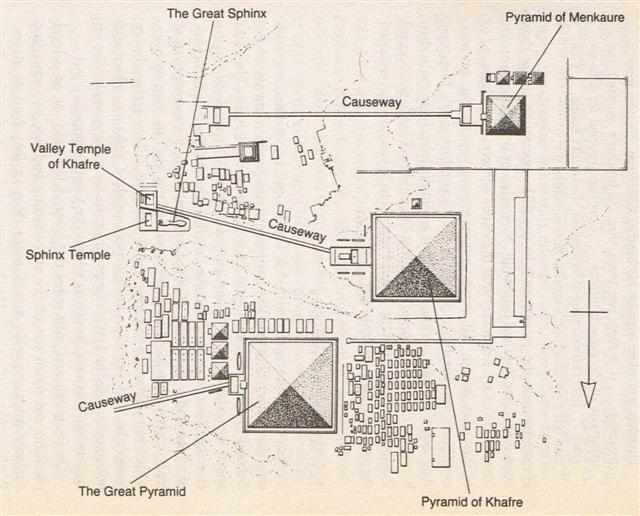
|
9-11 |
9-12 |
9-13 |
9-14 |
9-15 |
|
SEPT 26 |
27 |
28 |
29 |
30 (273 = 3 * 91) |
 |
 |
 |
 |
 |
|
Ga7-20 |
Ga7-21 (190) |
Ga7-22 |
Ga7-23 |
Ga7-24 |
|
9-16 |
9-17 |
9-18 |
9-19 |
9-20 |
9-21 |
|
OCT 1 |
2 |
3 |
4
(☼193) |
5 |
6 |
 |
 |
 |
 |
 |
 |
|
Ga7-25 (11 + 183)
|
Ga7-26 |
Ga7-27 |
Ga7-28 |
Ga7-29 |
Ga7-30 (199) |
|
17h (258.7)
ARRAKIS = μ Draconis
(258.7) |
Mula-19 (The Root)
SABIK (The Preceding One) =
η
Ophiuchi
(259.7), η Scorpii (259.9) |
NODUS I = ζ Draconis
(260.0), π Herculis (260.7),
RAS ALGETHI (Head of the Giant)
= α Herculis
(260.8) |
SARIN = δ Herculis
(261.0), ο Ophiuchi (261.4)
*220 = *261.4 - *41.4
ALRISHA (α Piscium)
|
ξ Ophiuchi (262.2), θ Ophiuchi,
ν Serpentis, ζ, ι Apodis
(262.4), ι Arae (262.8), ρ
Herculis (262.9)
*221 = *262.4 - *41.4 |
β, γ Arae (263.3), κ Arae
(263.5), σ Ophiuchi (263.6) |
  |
|
9-22 (*185) |
9-23 |
9-24 |
9-25 |
9-26 (☼185) |
|
OCT 7 (*200) |
8 |
9 |
10 |
11
(☼200) |
 |
 |
 |
 |
 |
|
Ga7-31 (200) |
Ga7-32 |
Ga7-33 (19 + 183) |
Ga7-34 |
Ga8-1 |
|
LESATH (Sting) =
υ
Scorpii,
δ
Arae (264.7),
CHOO (Club) =
α
Arae
(264.9) |
Al Shaula-17
ALWAID (Mother Camels) =
β
Draconis, MAASYM (Wrist) =
λ
Herculis
(265.1),
SHAULA (Sting) =
λ
Scorpii
(265.3),
KUMA =
ν
Draconis
(265.6),
σ
Arae (265.9)
HAMAL (α ARIETIS)
|
RAS ALHAGUE (Head of the
Serpent Charmer) = α Ophiuchi
(266.1),
SARGAS = θ Scorpii (266.3),
μ Ophiuchi, π Arae (266.5),
NAN HAE (Southern Sea) = ξ
Serpentis
(266.6), AL
DHĪLI (The Wolf) = ω
Draconis,
ι Herculis (266.7) |
λ
Arae (267.1),
GIRTAB (Seizer) =
κ
Scorpii,
ο
Serpentis (267.6),
DSIBAN (Wolf Pair) =
ψ
Draconis
(267.9) |
KELB ALRAI (Dog of the
Shepherd) =
β
Ophiuchi,
μ
Arae (268.1),
KEW HO (Nine Rivers) =
μ
Herculis
(268.6),
η
Pavonis (268.7),
APOLLYON =
ι
Scorpii
(268.9) |
 |
|
Dec 10 (*264) |
11 (345) |
12 |
13 |
14 (*268) |
|
°Dec 6 (*260) |
7 (341) |
8 |
9 |
10 (*264) |
|
'Nov 13 (*237) |
14 |
15 |
16 (320) |
17 (*241) |
|
"Oct 30 |
31
(☼220) |
"Nov 1 |
2 |
3 (*227) |
The pyramid of Menkaure had been built
to be smaller than the preceding pyramids although Alnitak was no less
bright than Mintaka and Alnilam - and
evidently more important:
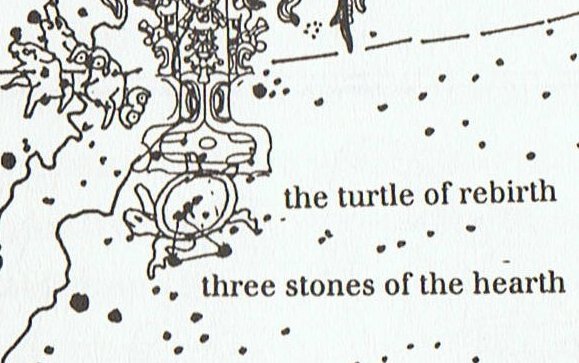
The pyramid of Khufu
had a pair
of V signs inside, one for the King and the
other for his Queen, that of the
King open towards the north pole
whereas that of his Queen had been covered
up (puo):
... The star [Thuban] could be seen,
both by day and night, from the
bottom of the central passage of the
Great Pyramid of Cheops (Knum
Khufu) at Ghizeh, in 30° of
north latitude, as also from the
similar points in five other like
structures; and the same fact is
asserted by Sir John Herschel as to
the two pyramids at Abousseir
...
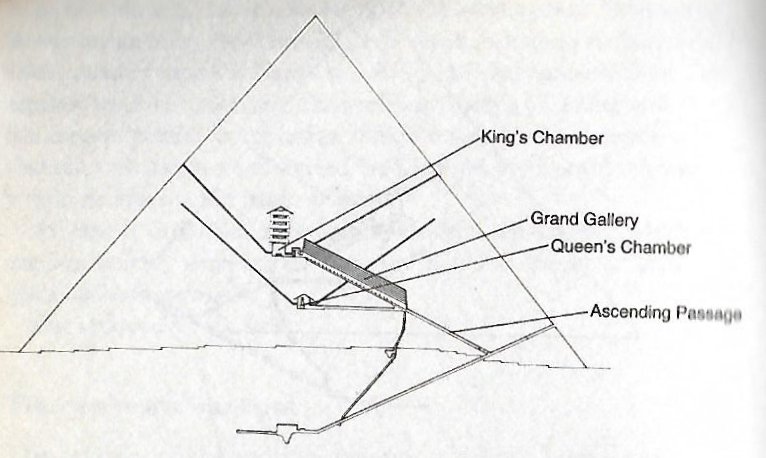
|
ARIES: |
|
1 |
Ashvini |
β and γ Arietis |
Horse's head |
April 17 (107) |
|
wife of the Ashvins |
Sheratan and Mesarthim |
|
2 |
Bharani |
35, 39, and 41 Arietis |
Yoni, the female organ
of reproduction |
May 1 (121) |
|
the bearer |
Musca Borealis |
|
TAURUS: |
|
3 |
Krittikā |
M 45 Tauri |
Knife or spear |
May 15 (135) |
|
the nurses of
Kārttikeya |
The Pleiades |
|
4 |
Rohini |
α Tauri |
Cart or chariot, temple,
banyan tree |
May 28 (148) |
|
the red one |
Aldebaran |
|
ORION: |
|
5 |
Mrigashīrsha |
λ, φ¹, and φ² Orionis |
Stag's head |
June
12 (163) |
|
the deer's head |
Heka |
|
6 |
Ardra |
α Orionis |
Teardrop, diamond, a
human head |
June 17 (168) |
|
the moist one |
Betelgeuze |
The head of the Stag
meant a place for counting:
... A sidelight falls upon the
notions connected with the stag by
Horapollo's statement concerning the
Egyptian writing of 'A long space of
time: A Stag's horns grow out each
year. A picture of them means a long
space of time.' Chairemon
(hieroglyph no. 15, quoted by
Tzetzes) made it shorter: 'eniautos:
elaphos'. Louis Keimer,
stressing the absence of stags in
Egypt, pointed to the Oryx (Capra
Nubiana) as the appropriate
'ersatz', whose head was, indeed,
used for writing the word rnp
= year, eventually in 'the Lord of
the Year', a well-known title of
Ptah. Rare as this modus of writing
the word seems to have been - the
Wörterbuch der Aegyptischen Sprache
(eds. Erman and Grapow), vol. 2, pp.
429-33, does not even mention this
variant - it is worth considering
(as in every subject dealt with by
Keimer), the more so as Chairemon
continues his list by offering as
number 16: 'eniautos: phoinix',
i.e., a different span of time, the
much-discussed 'Phoenix-period' (ca.
500 years) ...

Far up in the
north was Cassiopeia (the mother
of Andromeda) and she was formed
for telling time, much like the
Southern Cross down in the
south,
... The two great stars, which
marks the summit and the foot of
the Cross, having nearly the
same right ascension, it follows
that the constellation is almost
perpendicular at the moment when
it passes the meridian. This
circumstance is known to the
people of every nation situated
beyond the Tropics or in the
southern hemisphere. It has been
observed at what hour of the
night, in different seasons, the
Cross is erect or inclined. It
is a time piece, which advances
very regularly nearly four
minutes a day, and no other
group of stars affords to the
naked eye an observation of time
so easily made. How often have
we heard our guides exclaim in
the savannahs of Venezuela and
in the desert extending from
Lima to Truxillo, 'Midnight is
past, the Cross begins to bend'
...
because she was
basically either like a W(oman)
or like a M(an).
|
Egyptian tusk |
 |
Phoenician
shin |
 |
Greek
sigma |
Σ (σ, ς) |
|
Wikipedia: Shin
(also spelled in
(īn) or Sheen)
literally means 'teeth,
'press', and 'sharp' ...
The
symbol Σ is currently
used as an expression
for 'sum'. The
Phoenician shin
is oriented in another
way, similar to how
Cassiopeia is read in
the night when
in a low position - as
Celestial W when
below the pole, in
contrast to the
Celestial M when
above it.
Greek
sigma
therefore resembles
Cassiopeia in between,
when she was in the west
at the time when the Sun
was rising in the east.
 |
The Babylonians had
placed a Stag at Cassiopeia:

And the Mayas had her
as W in the center of their
Crododile Canoe:
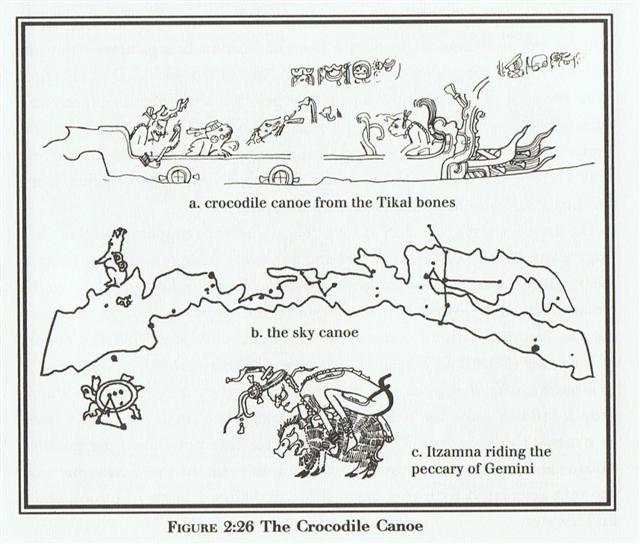
The pair of V signs
inside the Khufu pyramid were
oriented vertically, while those in
Cassiopeia were horizontally
oriented.
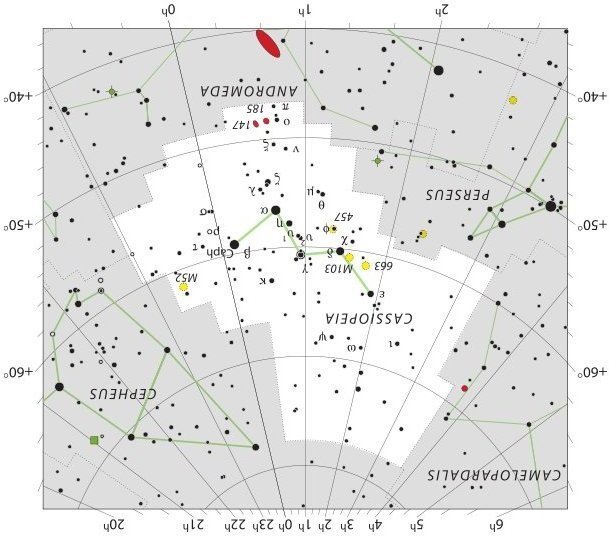
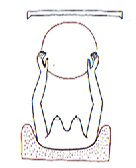
|
1-8 (370 + 3) |
1-9 (☼290) |
1-10 |
|
JAN 23 |
24 |
25 |
 |
 |
 |
|
Gb7-5 |
Gb7-6 (416 = 4 * 10) |
Gb7-7 (188) |
|
ANDROMEDA GALAXY (M31),
π Andromedae (7.7) |
ε Andromedae (8.2),
DELTA = δ Andromedae
(8.4),
SCHEDIR (Breast) = α
Cassiopeiae
(8.6), ζ Andromedae, μ
Phoenicis (8.9)
*8.4 + *365 - *41.4 =
*332 |
ξ Phoenicis (9.0), ρ
Tucanae (9.1),
DENEB KAITOS (Tail of
the Sea Beast) = β Ceti,
η Phoenicis (9.4),
AL NITHĀM (String of
Pearls) = φ¹ Ceti
(9.6)
*9.4 + *365 - *41.4 =
*333 |
|
March 28 (*372) |
29 (88) |
30 (454) |

|
|
Delta |
δ Andromedae |
8.4 |
March 29 (88 =
450 + 3) |
|
|
|
η Phoenicis
|
9.4 |
March 30 (89) |
|
- |
Zero |
η Andromedae |
11.4 |
April 1 (91 = 88 +
3) |
|
|
Whip |
Cih (γ Cassiopeiai) |
12.4 |
April 2 (92) |
|
Al Sharatain |
Pair of Signs |
β Arietis (Sheratan),
γ (Mesarthim) |
27.4 |
April 17 (107 = 104
+ 3) |
|
|
Musca Borealis |
35 (Head of the
Fly), 39
(Kaffaljidhma), and
41 Arietis (Bharani) |
41.4 |
May 1 (121 = 118 +
3) |
|
Al Dabarān |
Follower |
α Tauri (Aldebaran),
θ¹, θ²´,
γ (Hyadum I),
δ (Hyadum II), ε
(Ain) |
63.4 |
May 23 (143 = 140 +
3) |
|
Al Hak'ah |
White Spot |
λ Orionis (Heka),
φ¹, φ² |
83.4 |
June 12 (163 = 160 +
3) |
|
... The Heka triplet
is where we
otherwise would have
expected to see a
bright single star
representing Orion's
head (when looking
from a location in
the northern
hemisphere) ...
λ
and the two stars
phi furnish an
easy refutation of
the popular error as
to the apparent
magnitude of the
moon's disc, Colas
writing of this in
the Celestial
Handbook of
1892: In looking at
this triangle nobody
would think that the
moon could be
inserted in it;
but as the distance
from
λ
to
φ¹
is 27', and the
distance from
φ¹
to
φ²
is 33', it is a
positive fact; the
moon's mean apparent
diameter being 31'
7''. This illusion,
prevalent in all
ages, has attracted
the attention of
many great men;
Ptolemy, Roger
Bacon, Kepler, and
others having
treated of it. The
lunar disc, seen by
the naked eye of an
uninstructed
observer, appears,
as it is frequently
expressed 'about the
size of a
dinner-plate', but
should be seen as
only equal to a
peppercorn
...
...Al Maisān,
the title of
γ
Geminorum, by some
error of Firuzabadi
was applied to this
star as Meissa
[λ
Orionis}, and is now
common for it. Al
Sufi called it Al
Tahāyī; but Al
Ferghani and Al
Tizini knew it as
Rās al Jauzah,
the Head of the
Jauzah, which it
marks. The original
Arabic name, Al
Hak'ah, a White
Spot, was from the
added faint light of
the smaller
φ¹and
φ²
in the background,
and has descended to
us as Heka
and Hika.
These three stars
were another of the
Athāfiyy
[tripods used for
cooking] of the
Arabs; and
everywhere in early
astrology were
thought, like all
similar groups, to
be of unfortunate
influence in human
affairs. They
constituted the
Euphratean lunar
station
Mas-tab-ba-tur-tur,
the Little Twins, a
title also found for
γ
and
η
Geminorum; and
individually were
important stars
among the
Babylonians, rising
to them with the sun
at the summer
solstice, and, with
α
and
γ,
were known as
Kakkab Sar, the
Constellation of the
King
...
The Egyptian god
Heka was a magician
(sorcerer):
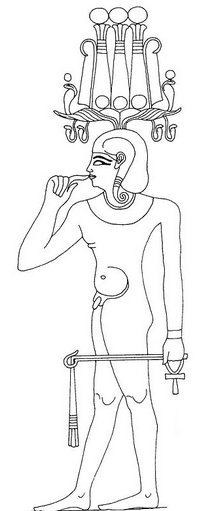 |
183 right
ascension days after Heka
(at the pyramid of Khafre)
was the Head of the
Serpent-charmer (Ga7-33):
... The 'classic' version,
however, was much more
detailed: the rope would
seem to rise high into the
skies, disappearing from
view. The boy would climb
the rope and be lost to
view. The magician would
call back his boy assistant,
and, on getting no response,
become furious. The magician
then armed himself with a
knife or sword and climbed
the rope, vanishing too. An
argument would be heard, and
then limbs would start
falling, presumably cut from
the assistant by the
magician. When all the parts
of the body, including the
torso, landed on the ground,
the magician would climb
down the rope. He would
collect the limbs and put
them in a basket, or collect
the limbs in one place and
cover them with a cape or
blanket. Soon the boy would
appear, restored
...
... They go inland at the
land. The child nursed and
tended grows up, is able to
go and play. Each day he now
goes off a bit further away,
moving some distance away
from the house, and then
returns to their house. So
it goes on and the child is
fully grown and goes to play
far away from the place
where they live. He goes
over to where some work is
being done by a father and
son. Likāvaka is the
name of the father - a
canoe-builder, while his son
is Kiukava.
Taetagaloa goes right
over there and steps forward
to the stern of the canoe
saying - his words are
these: 'The canoe is
crooked.' (kalo ki ama).
Instantly Likāvaka is
enraged at the words of the
child. Likāvaka says:
'Who the hell are you to
come and tell me that the
canoe is crooked?'
Taetagaloa replies:
'Come and stand over here
and see that the canoe is
crooked.' Likāvaka
goes over and stands right
at the place Taetagaloa
told him to at the stern of
the canoe. Looking forward,
Taetagaloa is right,
the canoe is crooked. He
slices through all the
lashings of the canoe to
straighten the timbers. He
realigns the timbers. First
he must again position the
supports, then place the
timbers correctly in them,
but Kuikava the son
of Likāvaka goes over
and stands upon one support.
His father Likāvaka
rushes right over and
strikes his son Kuikava
with his adze. Thus
Kuikava dies.
Taetagaloa goes over at
once and brings the son of
Likāvaka, Kuikava,
back to life. Then he again
aligns the supports
correctly and helps
Likāvaka in building the
canoe. Working working it is
finished
...
... Sorrowing, then, the two
women placed Osiris's coffer
on a boat, and when the
goddess Isis was alone with
it at sea, she opened the
chest and, laying her face
on the face of her brother,
kissed him and wept. The
myth goes on to tell of the
blessed boat's arrival in
the marshes of the Delta,
and of how Set, one night
hunting the boar by the
light of the full moon,
discovered the sarcophagus
and tore the body into
fourteen pieces, which he
scattered abroad; so that,
once again, the goddess had
a difficult task before her.
She was assisted, this time,
however, by her little son
Horus, who had the head of a
hawk, by the son of her
sister Nephtys, little
Anubis, who had the head of
a jackal, and by Nephtys
herself, the sister-bride of
their wicked brother Set.
Anubis, the elder of the two
boys, had been conceived one
very dark night, we are
told, when Osiris mistook
Nephtys for Isis; so that by
some it is argued that the
malice of Set must have been
inspired not by the public
virtue and good name of the
noble culture hero, but by
this domestic inadventure.
The younger, but true son,
Horus, on the other hand,
had been more fortunately
conceived - according to
some, when Isis lay upon her
dead brother in the boat,
or, according to others, as
she fluttered about the
palace pillar in the form of
a bird. The four bereaved
and searching divinities,
the two mothers and their
two sons, were joined by a
fifth, the moon-god Thoth
(who appears sometimes in
the form of an ibis-headed
scribe, at other times in
the form of a baboon), and
together they found all of
Osiris save his genital
member, which had been
swallowed by a fish. They
tightly swathed the broken
body in linen bandages, and
when they performed over it
the rites that thereafter
were to be continued in
Egypt in the ceremonial
burial of kings, Isis fanned
the corpse with her wings
and Osiris revived, to
become the ruler of the
dead. He now sits
majestically in the
underworld, in the Hall of
the Two Truths, assisted by
forty-two [42] assessors,
one from each of the
principal districts of
Egypt; and there he judges
the souls of the dead. These
confess before him, and when
their hearts have been
weighed in a balance against
a feather, receive,
according to their lives,
the reward of virtue and the
punishment of sin
...
... The
Serpent (Water) used the
Tree to climb up again.
After having earlier run
down from the Square at the
top of the Mountain:
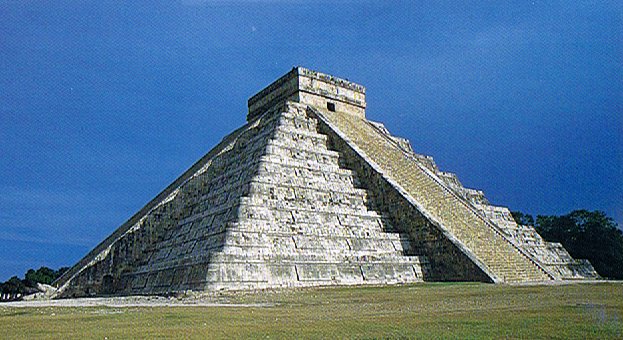
His
undulating climbing
corresponded to the
undulating text lines on a
rongorongo tablet, rising
from bottom up with the even
lines carrying its glyphs
oriented upside down. He was
like the first Mayan day
sign Imix (the Sea
Dragon):
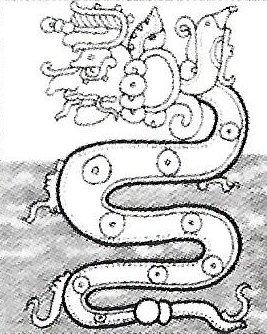
... The life-force of the
earth is water. God moulded
the earth with water. Blood
too he made out of water.
Even in a stone there is
this force, for there is
moisture in everything. But
if Nummo is water, it also
produces copper. When the
sky is overcast, the sun's
rays may be seen
materializing on the misty
horizon. These rays,
excreted by the spirits, are
of copper and are light.
They are water too, because
they uphold the earth's
moisture as it rises. The
Pair excrete light, because
they are also light ... 'The
sun's rays,' he went on,
'are fire and the Nummo's
excrement. It is the rays
which give the sun its
strength. It is the Nummo
who gives life to this star,
for the sun is in some sort
a star.' It was difficult to
get him to explain what he
meant by this obscure
statement. The Nazarene made
more than one fruitless
effort to understand this
part of the cosmogony; he
could not discover any chink
or crack through which to
apprehend its meaning. He
was moreover confronted with
identifications which no
European, that is, no
average rational European,
could admit. He felt himself
humiliated, though not
disagreeably so, at finding
that his informant regarded
fire and water as
complementary, and not as
opposites. The rays of light
and heat draw the water up,
and also cause it to descend
again in the form of rain.
That is all to the good. The
movement created by this
coming and going is a good
thing. By means of the rays
the Nummo draws out, and
gives back the life-force.
This movement indeed makes
life
...

... Gravitation moved
everything downwards, but
there had to be a return
force in order to keep the
cycles going. The first day
sign of the Mayas was
Imix (the water dragon)
and its undulating movements
illustrated how there was
another force than
gravitation, viz. the force
of growth
...
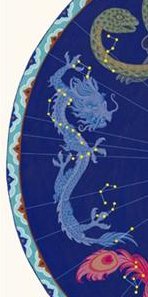
|
































